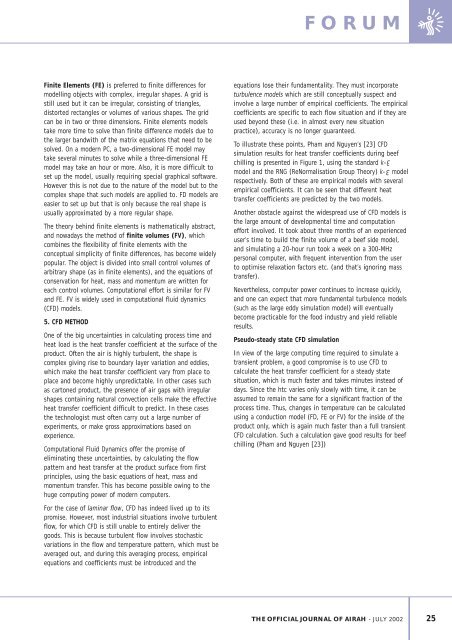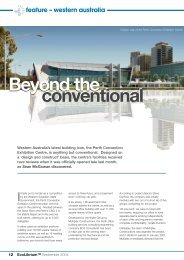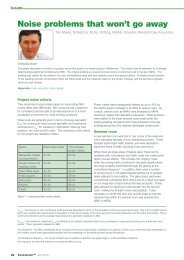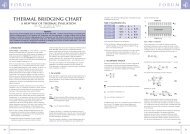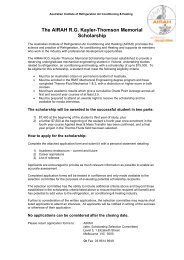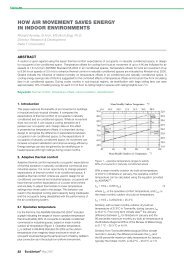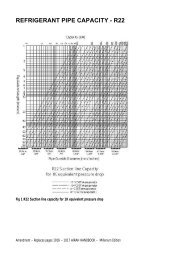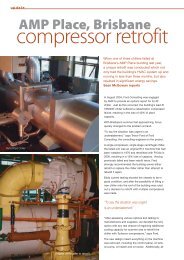calculation of processing time and heat load during food refrigeration
calculation of processing time and heat load during food refrigeration
calculation of processing time and heat load during food refrigeration
You also want an ePaper? Increase the reach of your titles
YUMPU automatically turns print PDFs into web optimized ePapers that Google loves.
Finite Elements (FE) is preferred to finite differences for<br />
modelling objects with complex, irregular shapes. A grid is<br />
still used but it can be irregular, consisting <strong>of</strong> triangles,<br />
distorted rectangles or volumes <strong>of</strong> various shapes. The grid<br />
can be in two or three dimensions. Finite elements models<br />
take more <strong>time</strong> to solve than finite difference models due to<br />
the larger b<strong>and</strong>with <strong>of</strong> the matrix equations that need to be<br />
solved. On a modern PC, a two-dimensional FE model may<br />
take several minutes to solve while a three-dimensional FE<br />
model may take an hour or more. Also, it is more difficult to<br />
set up the model, usually requiring special graphical s<strong>of</strong>tware.<br />
However this is not due to the nature <strong>of</strong> the model but to the<br />
complex shape that such models are applied to. FD models are<br />
easier to set up but that is only because the real shape is<br />
usually approximated by a more regular shape.<br />
The theory behind finite elements is mathematically abstract,<br />
<strong>and</strong> nowadays the method <strong>of</strong> finite volumes (FV), which<br />
combines the flexibility <strong>of</strong> finite elements with the<br />
conceptual simplicity <strong>of</strong> finite differences, has become widely<br />
popular. The object is divided into small control volumes <strong>of</strong><br />
arbitrary shape (as in finite elements), <strong>and</strong> the equations <strong>of</strong><br />
conservation for <strong>heat</strong>, mass <strong>and</strong> momentum are written for<br />
each control volumes. Computational effort is similar for FV<br />
<strong>and</strong> FE. FV is widely used in computational fluid dynamics<br />
(CFD) models.<br />
5. CFD METHOD<br />
One <strong>of</strong> the big uncertainties in calculating process <strong>time</strong> <strong>and</strong><br />
<strong>heat</strong> <strong>load</strong> is the <strong>heat</strong> transfer coefficient at the surface <strong>of</strong> the<br />
product. Often the air is highly turbulent, the shape is<br />
complex giving rise to boundary layer variation <strong>and</strong> eddies,<br />
which make the <strong>heat</strong> transfer coefficient vary from place to<br />
place <strong>and</strong> become highly unpredictable. In other cases such<br />
as cartoned product, the presence <strong>of</strong> air gaps with irregular<br />
shapes containing natural convection cells make the effective<br />
<strong>heat</strong> transfer coefficient difficult to predict. In these cases<br />
the technologist must <strong>of</strong>ten carry out a large number <strong>of</strong><br />
experiments, or make gross approximations based on<br />
experience.<br />
Computational Fluid Dynamics <strong>of</strong>fer the promise <strong>of</strong><br />
eliminating these uncertainties, by calculating the flow<br />
pattern <strong>and</strong> <strong>heat</strong> transfer at the product surface from first<br />
principles, using the basic equations <strong>of</strong> <strong>heat</strong>, mass <strong>and</strong><br />
momentum transfer. This has become possible owing to the<br />
huge computing power <strong>of</strong> modern computers.<br />
For the case <strong>of</strong> laminar flow, CFD has indeed lived up to its<br />
promise. However, most industrial situations involve turbulent<br />
flow, for which CFD is still unable to entirely deliver the<br />
goods. This is because turbulent flow involves stochastic<br />
variations in the flow <strong>and</strong> temperature pattern, which must be<br />
averaged out, <strong>and</strong> <strong>during</strong> this averaging process, empirical<br />
equations <strong>and</strong> coefficients must be introduced <strong>and</strong> the<br />
equations lose their fundamentality. They must incorporate<br />
turbulence models which are still conceptually suspect <strong>and</strong><br />
involve a large number <strong>of</strong> empirical coefficients. The empirical<br />
coefficients are specific to each flow situation <strong>and</strong> if they are<br />
used beyond these (i.e. in almost every new situation<br />
practice), accuracy is no longer guaranteed.<br />
To illustrate these points, Pham <strong>and</strong> Nguyen’s [23] CFD<br />
simulation results for <strong>heat</strong> transfer coefficients <strong>during</strong> beef<br />
chilling is presented in Figure 1, using the st<strong>and</strong>ard kmodel<br />
<strong>and</strong> the RNG (ReNormalisation Group Theory) k- model<br />
respectively. Both <strong>of</strong> these are empirical models with several<br />
empirical coefficients. It can be seen that different <strong>heat</strong><br />
transfer coefficients are predicted by the two models.<br />
Another obstacle against the widespread use <strong>of</strong> CFD models is<br />
the large amount <strong>of</strong> developmental <strong>time</strong> <strong>and</strong> computation<br />
effort involved. It took about three months <strong>of</strong> an experienced<br />
user’s <strong>time</strong> to build the finite volume <strong>of</strong> a beef side model,<br />
<strong>and</strong> simulating a 20-hour run took a week on a 300-MHz<br />
personal computer, with frequent intervention from the user<br />
to optimise relaxation factors etc. (<strong>and</strong> that’s ignoring mass<br />
transfer).<br />
Nevertheless, computer power continues to increase quickly,<br />
<strong>and</strong> one can expect that more fundamental turbulence models<br />
(such as the large eddy simulation model) will eventually<br />
become practicable for the <strong>food</strong> industry <strong>and</strong> yield reliable<br />
results.<br />
Pseudo-steady state CFD simulation<br />
FORUM<br />
In view <strong>of</strong> the large computing <strong>time</strong> required to simulate a<br />
transient problem, a good compromise is to use CFD to<br />
calculate the <strong>heat</strong> transfer coefficient for a steady state<br />
situation, which is much faster <strong>and</strong> takes minutes instead <strong>of</strong><br />
days. Since the htc varies only slowly with <strong>time</strong>, it can be<br />
assumed to remain the same for a significant fraction <strong>of</strong> the<br />
process <strong>time</strong>. Thus, changes in temperature can be calculated<br />
using a conduction model (FD, FE or FV) for the inside <strong>of</strong> the<br />
product only, which is again much faster than a full transient<br />
CFD <strong>calculation</strong>. Such a <strong>calculation</strong> gave good results for beef<br />
chilling (Pham <strong>and</strong> Nguyen [23])<br />
THE OFFICIAL JOURNAL OF AIRAH - July 2002<br />
3<br />
3<br />
25


